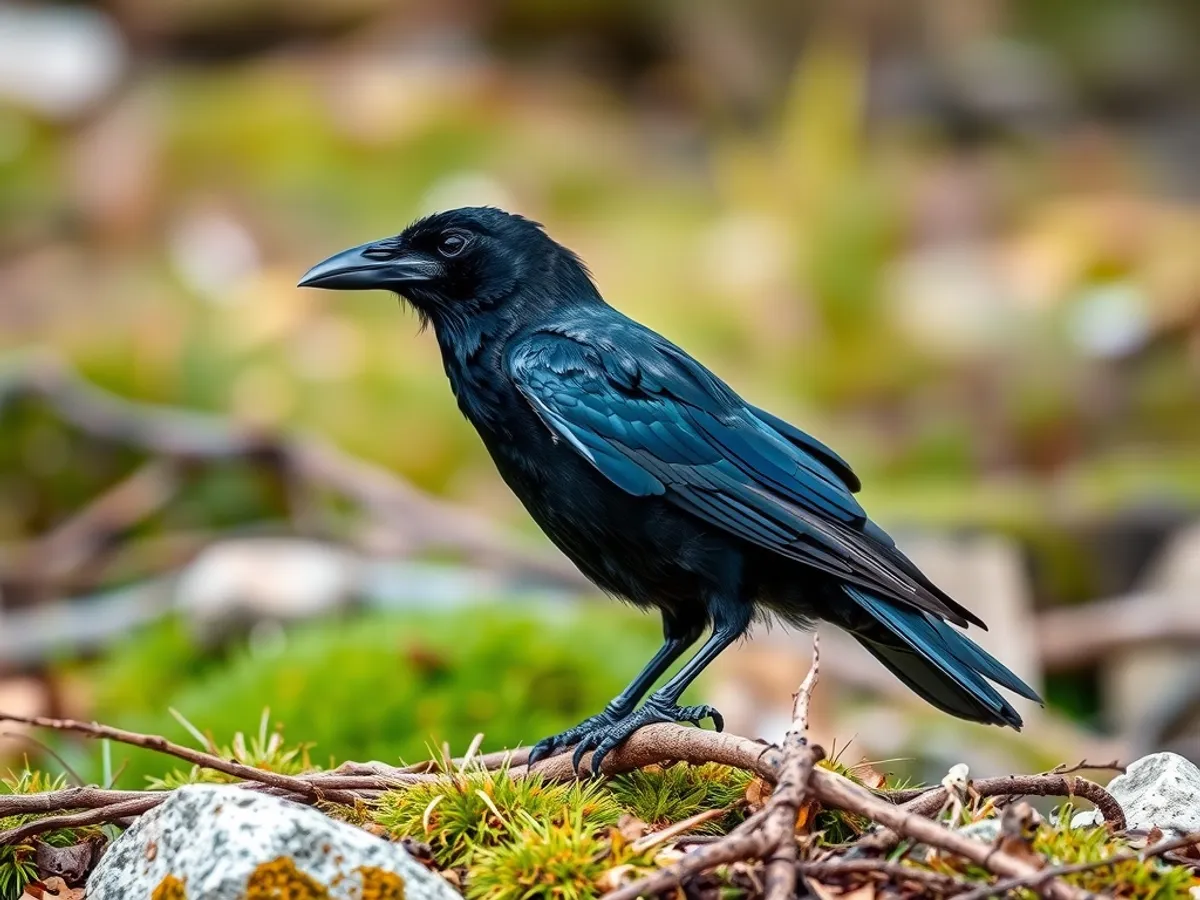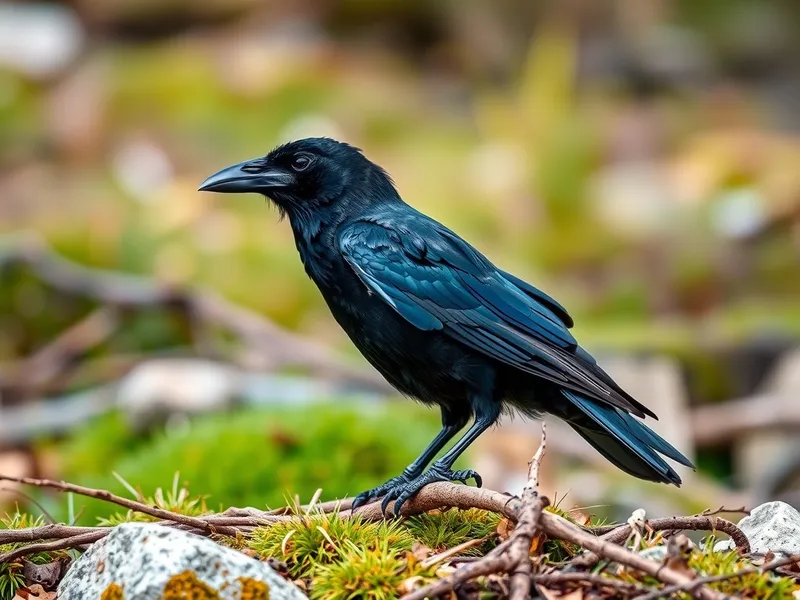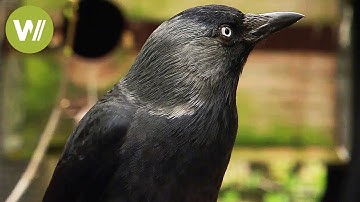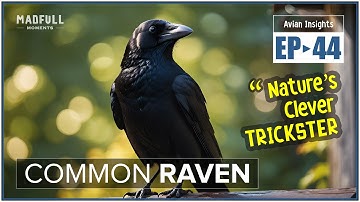
Common Raven
Corvus corax

Meet the Common Raven
The Common Raven is one of the largest and most intelligent birds in the world, recognized by its glossy black plumage, robust build, and wedge-shaped tail. Found across the Northern Hemisphere, this adaptable bird thrives in a wide range of habitats from forests and mountains to deserts and tundra. Ravens are known for their complex social dynamics, remarkable problem-solving abilities, and varied vocalizations, including the ability to mimic sounds. Their omnivorous diet and resourcefulness have enabled them to coexist closely with humans as well as in remote wilderness. Their impressive flight skills and playful behavior, such as aerial acrobatics, make them fascinating subjects of study.
Classification
Bird
Habitat
Forests, mountains, tundra, deserts, and coastal regions
Diet
Omnivore
Lifespan
10-15 years in the wild, up to 40 years in captivity
Conservation
Least Concern
Weight
0.7–2 kg
📖Fascinating Facts
Exceptional Intelligence
Common Ravens demonstrate advanced problem-solving skills and can use tools to obtain food, a rarity among birds.
Vocal Mimics
They have a wide variety of vocalizations and can mimic sounds from their environment, including other animals and machinery.
Lifelong Pairs
Ravens often mate for life and cooperate in raising their young, displaying strong pair bonds and social cooperation.
📋Detailed Description
The Common Raven (Corvus corax) is the largest member of the passerine order, with a robust body measuring 54–67 cm in length, a wingspan of 115–150 cm, and weighing between 0.7 and 2 kg, making it the heaviest songbird. Its plumage is entirely black with a metallic sheen, and it possesses a large, powerful bill and shaggy throat feathers known as hackles. The raven's wedge-shaped tail and long, fingered wings are distinctive in flight. Highly intelligent, ravens are capable of advanced problem-solving, tool use, and complex communication, including over 20 distinct vocalizations and the ability to mimic other sounds. Socially, they exhibit a flexible structure: juveniles often form loose flocks, while adults are typically territorial and monogamous, maintaining lifelong pair bonds. Their diet is omnivorous and opportunistic, ranging from carrion and small vertebrates to seeds, fruit, and human refuse. Ravens are known for their playful behaviors, such as aerial acrobatics, sliding on snow, and object manipulation. They are long-lived, with wild individuals known to survive over 20 years, and captive birds exceeding 40 years. Their adaptability allows them to thrive in diverse habitats, from Arctic tundra to deserts and urban environments.
💡 Did you know?
Ravens can imitate human speech and a wide range of other sounds, much like parrots.
🔬Research & Sources
Wikipedia Summary
The common raven or northern raven is a large all-black passerine bird. It is the most widely distributed of all corvids, found across the Northern Hemisphere. There are 11 accepted subspecies with little variation in appearance, although recent research has demonstrated significant genetic differences among populations from various regions. It is one of the two largest corvids, alongside the thick-billed raven, and is the heaviest passerine bird; at maturity, the common raven averages 63 centimetres in length and 1.47 kilograms in weight, though up to 2 kg (4.4 lb) in the heaviest individuals. Although their typical lifespan is considerably shorter, common ravens can live more than 23 years in the wild. Young birds may travel in flocks but later mate for life, with each mated pair defending a territory.
Last Modified: 6/5/2025
🎭Behavior & Social Structure
Common Ravens are diurnal and display a wide range of behaviors. They are both solitary and social, depending on age and season. Flocks of juveniles may form in resource-rich areas, while adults are territorial, especially during the breeding season. Ravens are renowned for their intelligence: they cache food for later consumption, use tools to access hard-to-reach food, and have been observed cooperating to achieve shared goals. Their diet is highly varied, including scavenging carrion, hunting small mammals, birds, insects, and reptiles, as well as consuming eggs, grains, berries, and even garbage. They often follow predators such as wolves to scavenge leftovers and have been documented dropping nuts onto roads for cars to crack. Communication is sophisticated, involving a repertoire of calls, body postures, and even non-vocal signals. Play is a notable aspect of their behavior, including aerial somersaults, games with objects, and interactions with other animals.
👶Reproduction & Life Cycle
Common Ravens are monogamous, forming long-term pair bonds that may last for life. Courtship involves aerial displays, mutual preening, and food sharing. Nesting typically occurs from late winter to early spring, with pairs constructing large nests of sticks, lined with softer materials, in tall trees, cliffs, or human structures. Females lay 3–7 pale greenish eggs with brown blotches, which are incubated solely by the female for 18–21 days. During this period, the male provides food. Both parents feed and protect the altricial chicks, which fledge at 5–7 weeks but may remain dependent on parents for several months. Breeding pairs defend their territory vigorously against intruders.
🛡️Adaptations & Survival
The Common Raven exhibits numerous adaptations for survival. Its strong, versatile bill allows it to tear flesh, crack bones, and manipulate objects. The dense, black plumage provides camouflage and thermoregulation, absorbing solar heat in cold climates. Ravens possess one of the largest brains relative to body size among birds, supporting advanced cognition, memory, and problem-solving. Their vocal flexibility facilitates complex social interactions and territorial defense. Physiologically, they can endure extreme temperatures and altitudes, aided by efficient respiratory and circulatory systems. Their ability to exploit a wide range of foods and habitats underpins their global success.
📚Research Sources
🎨Cultural Significance
Ravens hold a prominent place in human culture, mythology, and folklore worldwide. In Norse mythology, the god Odin was accompanied by two ravens, Huginn and Muninn, symbolizing thought and memory. In many Indigenous cultures of North America, the raven is a creator and trickster figure, often credited with shaping the world. In literature and art, ravens are associated with mystery, prophecy, and intelligence, famously featured in Edgar Allan Poe's poem 'The Raven.' Their striking appearance and complex behaviors have made them enduring symbols of both wisdom and omens.
🔬Recent Research & Discoveries
Recent genetic studies have revealed significant divergence among raven populations, with evidence of ancient hybridization between lineages in North America and Eurasia, challenging traditional subspecies classifications. Ongoing research focuses on their cognitive abilities, including planning, theory of mind, and social intelligence, often paralleling those of primates. Studies have documented their use of referential gestures, cooperative problem-solving, and even an understanding of cause and effect. Ecological research examines their impact on sensitive species, particularly in areas where human activity has altered predator-prey dynamics.
🎥Wildlife Videos

Ravens - Intelligent Rascals of the Skies | Free Documentary Nature
Ravens - Intelligent Rascals of the Skies | Free Wildlife Documentary Hardly any other species of bird has preoccupied mankind ...
Free Documentary - Nature

Ravens and crows - the most intelligent birds in the world (animal documentary in HD)
Crows accomplish spiritual benefits that were confidenced only by humans and apes. Click here for more documentaries: ...
wocomoWILDLIFE

Mindblowing Raven Facts: Watch and Learn!
Are you curious about ravens and want to learn more? Look no further! This video is packed with mindblowing facts about these ...
Animal Behavior Corner

Ravens (2001)
Exploring ravens' intelligence, adaptability, sociability and image. The raven is a sign of life in Amerindian mythology, while ...
ThisOldVideo2

Ravenous Raven | National Geographic
About National Geographic: National Geographic is the world's premium destination for science, exploration, and adventure.
National Geographic

Common Raven → Nature's Clever Trickster ● #facts @MadfullMoments ◌ EP►44
Common Raven → Nature's Clever Trickster ○ #facts @MadfullMoments ◌ EP▻44 The Common Raven (Corvus corax) is a bird ...
Madfull Moments
🌍Habitat Information
The Common Raven typically inhabits Forests, mountains, tundra, deserts, and coastal regions environments. Common Ravens have adapted to their environments with specialized features and behaviors.
Primary Habitat:
Forests, mountains, tundra, deserts, and coastal regions
More detailed habitat information will be available soon.
🛡️Conservation Status
The Common Raven is currently classified as Least Concern. Conservation efforts are crucial for preserving this species for future generations.
Common Threats:
- 🏠Habitat loss and fragmentation
- 🌡️Climate change impacts
- 🎯Hunting and poaching
- 🏭Human-wildlife conflict
⚠️Threats & Conservation Challenges
Globally, the Common Raven is classified as Least Concern, with stable or increasing populations in many regions due to their adaptability. However, local declines have occurred where persecution, habitat loss, or poisoning (often as a result of predator control programs) are significant. In some areas, ravens are considered pests due to their predation on livestock or crops, leading to targeted control measures. Conversely, in human-altered landscapes, populations may increase, sometimes impacting sensitive wildlife through nest predation. Climate change may alter their range and food availability, but their generalist nature buffers them against many environmental changes.
🔬Scientific Classification
Scientific Name
Corvus corax
Classification Hierarchy
🔍 About Taxonomic Classification
Taxonomic classification is a hierarchical system used by scientists to classify and organize living organisms based on shared characteristics and evolutionary relationships.
The system moves from broad categories (Kingdom) to increasingly specific ones, with each animal's scientific name typically consisting of its Genus and species.
📝Community Notes
Share your observations and insights about the Common Raven with our community of wildlife enthusiasts.
Join Our Community
Sign in to share your observations and connect with fellow wildlife enthusiasts.
Sign In to ContributeNo community notes yet
Be the first to share your observations about the Common Raven!
Explore Common Raven
Select a tab above to learn more about this amazing animal.
📸Photo Gallery
No photos available for this animal yet.
🌟Discover More Wildlife
Continue your journey of discovery with more fascinating animals from our database
